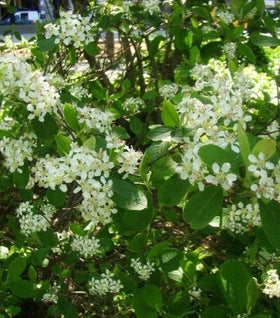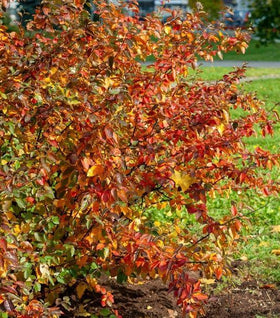Chokeberry Shrubs for Sale Online
The Chokeberry bush or Aronia Shrubs are a fruit-bearing deciduous shrub. Chokeberry shrubs are native to the Eastern half of the United States and can typically be found in wet woods and swamps of Eastern North America. They produce white flowers in the spring and produce their fruits in the fall. Aronia is an excellent shrub to grow that will draw birds to the garden in the fall and winter.
Chokeberries can be canned as jam or jelly, and they also make healthy fruit drinks. Aronia berries contain high levels of antioxidants and may help reduce the risk of cancer and heart disease.
Aronia is a great addition to the landscape and is well known for the striking fall foliage, a brilliant blend of red and orange. Birds love the fruits of Aronia Plants, but they love them at different times of the year. The red chokeberry has bright red fruit that is not the first choice of birds and tends to remain on the branches through much of the winter.
In the late winter and very early spring, birds will eat the red berries. At the same time, the black chokeberry bush Aronia melanocarpa has purplish-black berries that ripen earlier and are the first of the chokeberries to be eaten.
Growing Aronia Chokeberries in the Landscape
Aronia is cold hardy in the north to zone 3 for the Black Chokeberry. Red Chokeberries are not quite as hardy, and their hardy zones go north to zone 4.
In the spring, Chokeberry shrubs produce white flower clusters, which draw in pollinators and glossy green leaves. They prefer to be planted in full sunlight to part shade. Aronia in full sun typically yields more flowers, more fruit, and brighter fall color. Aronia's fall color in partial sun to shade tends to have a fall color that leans more towards the orange side.
They grow equally well in well-drained soils and soil that tends to stay wet. Chokeberry plants look best when grouped in clusters of three plants. Aronia is not deer resistant but is not often bothered as deer tend to favor other plants over Aronia.
Using Chokeberry Shrubs in the Rain Garden
Aronia naturally grows in wet woodlands and bogs, making them perfect plants for rain gardens. Aronia is also salt tolerant, making them useful as rain garden plants along seawalls or roads where salt is applied in the winter. If you have an area in the garden or lawn that stays consistently wet and very few other shrubs have survived, plant Aronia. Your local extension service is glad to help with designing the perfect rain garden for your lawn and landscape.
Types of Chokeberries
The Black Chokeberry or Aronia melenocarpa is typically found in the northeastern part of the country and is slightly more hardy than its red cousin. In the spring, fragrant white flowers start the show. Birds favor the fruits in the fall and early to mid-winter.
The fall color is orange, red, and yellow and can often have some purple as well. They will grow to about 6 feet tall and about as wide. Aronia Autumn Magic is the superior cultivar of the Black Chokeberries. It is faster growing than the species and produces a far superior fall color.
Red Chokeberry or Aronia arbutifiolia has a larger native range and can be found in the North East from New York south to Florida and west to Ohio and Texas. It grows taller than black chokeberry and can reach up to 10 feet in height and reach 6 feet wide but typically stays a little slimmer.
In the spring, the white flowers are also the showpiece. Fall color leans more towards the red side and is often compared to the burning bush shrubs. Red Chokeberries also produce more berries than their black counterparts.
Using Chokeberry Shrubs as a Groundcover
Aronia Ground Hog is a recent introduction that grows to only 14 inches tall with a spread of 3 feet. It is a cultivar of Aronia melenocarpa and produces the same flowers, fruit, and fall color. It was bred to be used as a groundcover and works perfectly on hillsides, dry areas, and any area where other plants have failed.
Aronia Shrubs in Containers and Patio Pots
Aronia Groundhog is a perfect "filler" in mixed containers due to its drought tolerance. Use a taller evergreen plant as the "thriller," and there's no need to worry about the Aronia taking over. In the fall, the brilliant fall color will create interest and prolong the beauty of your containers.
Growing Aronia Plants for Berry Harvesting
Aronia berries are used in Jams, Jellies, baking, and, more recently, wine-making. If you're growing Aronia for the fruits, it is suggested that you protect the plants with bird netting to keep your feathered friends from making off with your potential harvest. Remember that birds love chokeberries as much as you do and maybe slightly more so, if possible, leave some behind for the birds.


